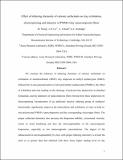Effect of tethering chemistry of cationic surfactants on clay exfoliation, electrospinning and diameter of PMMA/clay nanocomposite fibers
Author(s)
Wang, M.; Yu, Jian H.; Hsieh, A. J.; Rutledge, Gregory C
Downloadwang_101063R1_ms.pdf (9.149Mb)
PUBLISHER_CC
Publisher with Creative Commons License
Creative Commons Attribution
Terms of use
Metadata
Show full item recordAbstract
We examine the influence of tethering chemistry of cationic surfactants on exfoliation of montmorillonite (MMT) clay dispersed in methyl methacrylate (MMA) followed by in-situ polymerization to form poly(methyl methacrylate) (PMMA) nanocomposites, the effect of exfoliation and clay loading on the rheology of polymer/clay dispersions in dimethyl formamide, and the diameters of nanocomposite fibers formed from these dispersions by electrospinning. Incorporation of an additional reactive tethering group of methacryl functionality significantly improves the intercalation and exfoliation of clays in both in-situ polymerized PMMA nanocomposites and the corresponding electrospun fibers. The proper surfactant chemistry also increases the dispersion stability, extensional viscosity, extent of strain hardening and thus the electrospinnablity of the nanocomposite dispersions, especially at low nanocomposite concentrations. The degree of the enhancement in electrospinnability by clays with proper tethering chemistry is at least the same as or greater than that obtained with three times higher loading level of clay particles without proper tethering chemistry in the nanocomposites. These results suggest a new strategy to produce smaller diameter fibers from very dilute polymer solutions, which are otherwise not electrospinnable, by incorporating a small amount of well-exfoliated clays.
Date issued
2010-10Department
Massachusetts Institute of Technology. Institute for Soldier Nanotechnologies; Massachusetts Institute of Technology. Department of Chemical EngineeringJournal
Polymer
Publisher
Elsevier
Citation
Wang, M., J.H. Yu, A.J. Hsieh, and G.C. Rutledge. “Effect of Tethering Chemistry of Cationic Surfactants on Clay Exfoliation, Electrospinning and Diameter of PMMA/clay Nanocomposite Fibers.” Polymer 51, no. 26 (December 2010): 6295–6302.
Version: Author's final manuscript
ISSN
00323861